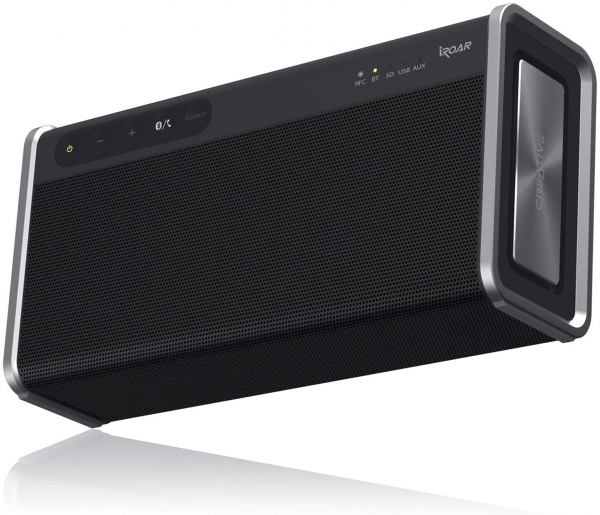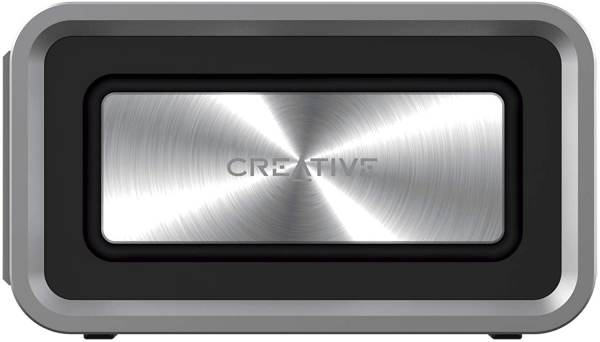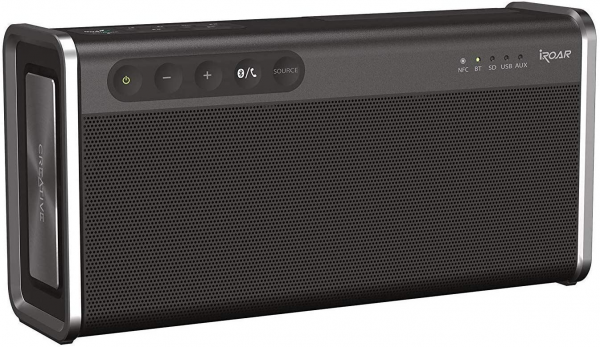Creative
Creative iRoar Go: a sound Swiss army knife
Aprox. 119€ - see price -
See specificationsThe iRoar Go fills the ranks of the Roar nomad series from Creative. It offers a variety of versatile connections, a compact and light design, increased water resistance (IPX6) and increased autonomy.
Positive points
Size / power ratio.
Pretty bass / rather rich restitution.
Very complete connectivity.
Numerous indications and commands.
The return of the USB sound card function.
Complete and reactive application.
Bad points
Sibilance.
Pronounced directivity / limited radiation.
Weak autonomy.
No self-power supply via USB.
Our review
Ergonomics
A worthy member of Creative's Roar series, the iRoar Go comes in the same form and with the same materials as the previous iteration. Nomadic aspiration obliges, it gains in compactness and lightness compared to the iRoar, but remains nevertheless quite bulky for a portable speaker. The grip is relatively good and the speaker can be placed flat or upright like its cousin the Roar 2. However, it remains much more stable flat thanks to its non-slip feet.
With its thick plastic chassis coupled to aluminum and a metal grid, the iRoar Go enjoys a solid and serious manufacturing. The enclosure is also splashproof (IPX6) and therefore does not fear splashes of water or sand. Just make sure to place the two rubber covers that protect the connections.
The iRoar Go is similar to the Roar 2 in many respects, particularly with regard to connectivity. Apart from all this armada of controls and possibilities, the iRoar is nonetheless easy to use. The controls respond very quickly and pairing via Bluetooth (4.2, A2DP, AVRCP, HFP) is done without problem, especially with the NFC chip. The possibilities are very numerous for a portable speaker: wired connection of all kinds, USB reading and SD card, hands-free kit with recording, use of the mini-jack input as microphone or headphone output ...
To complete the picture, we also have the right to the Sound Blaster Connect smartphone app, complete and responsive. It gives access to the choice of connected sources, an overview of the music being played, a file explorer for connected devices (USB key, micro SD card) and above all an equalization part.
The iRoar Go offers a complete user experience: there are a series of controls on the front panel with power on / off, volume control, answer calls, Bluetooth pairing and choice of source. It is also possible to navigate between tracks with other buttons.
Some points disappoint us, however, such as the lack of self-supply of the speaker in sound card mode via USB or the poor quality of the hands-free kit. This is also the case for autonomy, which does not live up to its 12-hour promise. At best, whether wired or Bluetooth, we have not managed to exceed 10 hours at very moderate volume. Rather count 6 to 8 hours at a good level of listening and 4 to 5 hours with a device charging USB.
Other controls are accessible via the upper part, accompanied by the connectors (USB-A connector for charging and reading, micro-USB to connect the speaker / sound card to a computer, microSD slot, mini-jack 3, 5 mm and mains power socket).
Luminous indications make it possible to see more quickly which source is selected, the state of the pairing in Bluetooth or if certain sound functionalities are activated (Roar, EQ). There are also many audio / voice alerts. We would still have preferred that the one played when the speaker was started to be more discreet and that the low battery alert does not happen as often and as loud. A "battery low" alert which intervenes every minute and which covers the listening in progress, it is very tiring! If you can't take it any more, know that the application allows to deactivate all the audio / vocal indications.

Audio
The iRoar Go offers a rich and powerful sound rendering, but which would have benefited from being much more diffuse and detailed. The whole group finds it difficult to express itself naturally and freely, as if the enclosure contained the scene within it.
Given its compactness, the speaker offers very deep bass, with good overall seating. Low mids are privileged and propel the proximity of the voice, percussions (bass drum, snare drum and toms, for example), the piano or even the bass. It is still compact and bushy without equalization. In addition, this boost tends to hide a little higher frequency zones when listening to songs rich in frequency. The rest of the spectrum remains fairly balanced, if not in the treble. A fairly significant peak in distortion taints the sound in this area, making it a little too aggressive and boosting the sibilance, especially when you raise the listening level. Strangely, this compact reproduction is coupled with an exaggeration of the room effects (reverberations, delay, etc.) because of the meteoric rise after around 13 kHz. The device could have seemed more natural and pleasant if the enclosure was not very directive.
Indeed, the enclosure really aims in front of it when it is placed upright and it is necessary to be well at height. The stereophony is not the widest and the SuperWide mode present in the EQ of the application is unfortunately not really exploitable because of the much too high emphasis of the high-mid / treble.
Personal equalization allows you to gain readability in the low / low mids and to calm the very high frequencies very slightly, even if you lose the "wow" effect of the flattering rendering of the iRoar Go. The other presets offered are not really interesting because of the imbalance they often cause. Finally, the Roar mode more strongly marks the V signature by boosting both the low / low-mid and high-mid / treble, leaving behind the intelligibility of the voice. In addition, the latter applies to a kind of volume boost (with or without dynamic compression) to give a greater impression of power.
The Creative iRoar Go shows very good power, which however cannot be used 100% because of the points mentioned above. The speaker can reach 85 dB without problem, but we stick to more reasonable levels which still allow to sound a living room, kitchen or outdoor terrace, for example.
Finally, the communication latency in Bluetooth is 200 ms. There is a latency between sound and image and you will have to try to reduce this gap if your reading software allows it.

Conclusion
The Creative iRoar Go aligns with its cousin, the Roar 2, by offering an ultra-complete experience for a portable speaker, but not without some faults. The autonomy is still too low and the sound rendering still lacks a little bit of homogeneity to match the best nomad speakers.

Specifications
Reviews


A small Bluetooth speaker with Bi-amplification?! This I have to try.
I've been an audiophile for a very long time. I bought my first high-end audio system at age 18, and have owned many since. Back then it was a science. He talked about signal-to-noise ratio, dynamic range and total harmonic distortion. We anxiously awaited innovative products. Every once in a while something would come out of left field and the entire industry would be astounded. I place this little speaker into that category ...... innovation out of left field. I never imagined a small, two pound speaker system with bi-amplification. Until now, this has been reserved for very high-powered and very expensive audio systems. That's why I bought this little speaker ..... curiosity. And this from Creative Labs ?! Don't they make computer parts? Hmmm ....... worth a look .... and a listen.
I was looking for something with decent sound quality (for a small speaker) to replace my current travel speaker, which sounds good, but weighs almost five pounds. Reading through the other reviews it seems that people expect concert hall volume and clarity out of the smallest of sound systems. That just isn't going to happen. This takes mass and lots of power. I wasn't expecting this at all. I want a speaker that can serve as background music while I'm working away in a hotel room on any of the four continents I travel to regularly (and .... the write-up didn't say anything about this speaker coming with a power supply with interchangeable plugs for the US, Europe and the UK !! .... but it does, and auto select voltage too).
So, this little speaker arrives from Amazon. I plug it in to charge the battery and play some low volume music through it for five hours (you can ruin a speaker by hitting it hard when its brand new .... the glue has to give a little on the drivers). After the break-in, I went straight to the song that I always use to audition an audio system ..... True Colors by Cyndi Lauper. It did a very good job with this song. I was impressed. Yes, if you push it very far past the RMS power level (.707 of peak power) it will distort ... especially with a severely limited dynamic range source such as Bluetooth. That's to be expected. It's math. I'm an electrical engineer. I do math. I know the limitations the designers face. If you take into consideration the physical size of this speaker, it does an amazing job. A speaker has to move air. The smaller it is, the less air it can move. The designers came up with a passive radiator system on each end that visibly moves !! I wasn't expecting that. I'm impressed, and I'm not easily impressed. To the designers from a colleague ..... and I hope you see this ..... BRAVO !! This is an overall top quality product.
Sounds fantastic, app seems a bit behind technologically, needs updating/support
After exhausting amount of research, I found the perfect blend of small size and excellent audio quality. The iRoar Go is the perfect combination. It has basic "splash proof" protection, but I wasn't too worried about this.
When the prince went down to <$ 100, I grabbed it and love the sound, very high quality. However, it seems behind the times technologically ...
When I want to switch from listening from one bluetooth device to another, I have to either shut off the speaker, bluetooth on the first device or re-pair for the second device to connect. It's like it can't handle multiple connection memory? If you only listen via your phone, for example, that's fine. But, when you want to switch from listening from, for example, your computer to your phone, it's a pain.
Secondly, the app is VERY poor. It seems that SoundBlaster has just left this app in the weeds, forgot about it. The app for OS X on the app store is way too old to install on a current MacBook. So, there is no controlling the sound if you use your computer to connect to the speaker! The app on the phone, as rudimentary as it is, at least gives you equalizer adjustments!
If SoundBlaster is still selling this as a current model, they should continue to support it.
Speaker sound- fantastic
SoundBlaster- disappointing
I love this little well built speaker!
After several years years listening to my JBL Charge 2+, and bemoaning its lack of upper mids and anything resembling a treble range I decided I needed to do better. Much Better. I was to the point where I was no longer enjoying listening to the Charge 2+. After months of going through the myriad of reviews, and listening to others at Bestbuy and other retailers, I decided to purchase, unheard, a bluetooth speaker by Creative Labs, the iRoar Go. It's previous bluetooth speakers had gotten very good reviews and held up quite well on YouTube videos when compared to others.
I still wanted good sound in a small package, portability, lasting battery, and balance. Well, I seem to have found that in the Creative Labs iRoar Go. I am mighty impressed with this solid little performer. In just 2 days, I have retired the Charge 2+ forever.
It took 5 hours or so before ithe iRoar Go started to sounds it's best. So yeah you will want it to burn in some before you really test it out, but the waut will be worth it. I can hear all of the music that I sorely missed listening the the JBL. While the Charge2 + excelled in lower end grunt, it was overly so at the expense of everything else. It sounded like a wet washcloth was over it. The iRorar Go, not so much. Sound was open, clear and detailed, AND had bass. There was balance there, except perhaps when listening to certain voice settings that emphasized the upper range frequency's. There are several options for tailoring the sound and it didn't take long to find what I liked. Again, for the $ 150 I spent, I am extremely satisfied already.
Another feature I found useful and necessary is the app that allows me to alter the sound to my liking. It is very helpful in the initial stages of locating the sound that appeals to you. All of the main voice settings, along with EQ options are done from the app. My only regret is that Creative did not give me the ability to change speaker settings when using my laptop via Bluetooth. For some inexplicable reason the app will only work when the iRoar Go is connected via USB, not bluetooth. That was a mistake that I hope gets corrected. I also would have liked to see more EQ options directly on the unit itself to allow toggling between at least to voice options in case I didn't want the "superwide" voice to be my only choice.
I love this little perfectly sized speaker for its sound above all, but there are many many other features that you will enjoy should you need them, so yeah, put this one on your list of under $ 200 Bluetooth speakers to audition. Especially if you own a JBL Charge of any generation. It just blows it away. At $ 150 you can't go wrong. For me at least, it rocks!